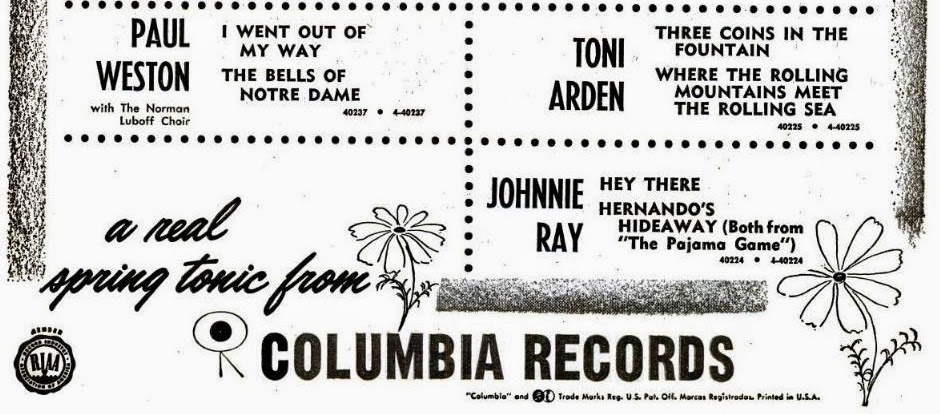The discussions that took place in the comments section of this post spurred me to do a little thinking about and research into this famous Columbia trademark, the so-called "walking eye."
When I was a kid of four or five, I was always a bit spooked out by the logo, at least in its redesigned form as shown above, which was new at the time. Those concentric circles, drawn more thickly on the sides than on the top and bottom, and surrounding that staring pupil, seemed so sinister to me! I realized, even then, that it was a variant of the symbols lining the edges of the "6-eyes" label, several hand-me-down specimens of which I possessed:
...but those symbols looked so much "friendlier" to me, and the variant seemed like a corruption.
So where did that symbol come from? Well, according to Gary Marmorstein's readable but inaccuracy-laden history of Columbia, "The Label" (Thunder's Mouth Press, 2007), it was the brainchild of Neil Fujita, who was brought in as Columbia's art director in 1954. "Early in his tenure there," writes Marmorstein, "Fujita took a good long look at [CBS art director] Bill Golden's CBS Eye and reworked it so that it looked like a cartoon version of a decibel, a bug regurgitated in hi-fi. With two legs added, it also looked like a TV antenna turned upside down; the lines that stood out showed a C and an R, mashed together, that stood for Columbia Records."
Sounds plausible enough, but lately I've been digging around in old Billboard magazines online, scouring Columbia ads from the middle 1950s, and the first appearance I can find of the "eye" logo is this one, where it forms the "O" in "COLUMBIA" (February 13, 1954):
(In case you're wondering, the snappy new musical in question is "Red Garters," the soundtrack of which was on CL 6282.) Yes, the C and the R do stand out (they're even inked more darkly in "COLUMBIA" and "Rosemary" so that you don't miss the point), but what also stands out is that without the "legs" the new logo looks like a record, not like an eye at all! So I'm a little suspicious of Marmorstein's (or Fujita's) story; the only part of it that really seems accurate is the "CR" origin of the logo. Besides, the dates don't add up. If Fujita came to Columbia in 1954, and this ad appeared in February, it seems highly unlikely the logo originated with him, whatever hand he may have had in developing it later.
It seems more likely that it was a happy accident, one that the folks at Columbia seized on eagerly. By this time, the trusty old notes-and-microphone logo
may have seemed like a relic, one associated with a 78-rpm past rather than an LP future. (After all, the "Magic Notes" in the left circle had been around since 1908!) By the end of 1953 Columbia's Billboard ads were no longer showing the Notes prominently, instead relegating them to the fine print, as if setting the stage for something new to take their place. (The picture above is from the Oct. 3, 1953, issue of Billboard, and represents the last occurrence I can find of so large a display of the Notes.)
The next time we encounter the Eye in Billboard advertising is in April 1954, when an ad appears encouraging dealers to obtain the 1954 catalog of 45-rpm Extended Play records, a small picture of which appeared in the ad. I managed to find an Ebay listing for the catalog with a nice picture (but alas, not in time to actually buy it!), since the picture in the Billboard ad doesn't do it justice:
The "CR" origins of the new logo stand out really nicely here. Appropriately, the Eye is combined here with the logo Columbia was using for EPs:
By May 22, the Eye is being displayed at the bottom of Billboard ads, and without the division down the middle that characterized its first appearances:
Meanwhile, on the back covers of Columbia's LP albums, we begin to find the following gracing the bottom (image taken from ML 4853, a Gold & Fizdale two-piano recital probably released in April 1954):
Finally, the Eye's first appearance on an actual record label: In October, 1954, Columbia announced a new series in a Billboard ad, the "Hall of Fame" series, dedicated to reissues of pop material on 45s and 78s. The 78 labels looked like this (image borrowed from "Note the Notes," Mike Sherman and Kurt Nauck's book about Columbia's 78 labels):
Notice that by now, Columbia has declared the Eye to be a trademark. Notice, also, the subordinate position of the Notes. They would be dropped altogether from the next label design, namely the "6-eyes" label pictured at the beginning of this article, developed for LPs and introduced in the summer of 1955, though they would continue appear on pop 78s until the end of their run in 1958, and on 45s until about the same time.
Part 2 of this series can be found here, with a survey of album cover branding from 1954-57.












